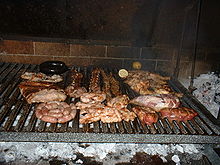
Back مطبخ أرجنتيني Arabic Argentina mətbəxi Azerbaijani Аргенцінская кухня Byelorussian Argentinská kuchyně Czech Coginiaeth yr Ariannin Welsh Argentinische Küche German Argentina kuirarto Esperanto Gastronomía de Argentina Spanish Argentinako gastronomia Basque آشپزی آرژانتینی Persian
This article needs additional citations for verification. (August 2024) |
| Part of a series on |
| Argentine cuisine |
|---|
| Regional cuisines |
| Ingredients and types of food |
| See also |
| Part of a series on the |
| Culture of Argentina |
|---|
 |
| Society |
| Topics |
| Symbols |
|
|

Argentine cuisine is described as a blending of cultures, from the Indigenous peoples of Argentina who focused on ingredients such as humita, potatoes, cassava, peppers, tomatoes, beans, and yerba mate, to Mediterranean influences brought by the Spanish during the colonial period. This was complemented by the significant influx of Italian and Spanish immigrants to Argentina during the 19th and 20th centuries, who incorporated plenty of their food customs and dishes such as pizzas, pasta and Spanish tortillas.
Beef is a main part of the Argentine diet due to its vast production in the country's plains. In fact, Argentine annual consumption of beef has averaged 100 kg (220 lb) per capita,[1] approaching 180 kg (400 lb) per capita during the 19th century; consumption averaged 67.7 kg (149 lb) in 2007.[2]
Beyond asado (the Argentine barbecue), no other dish more genuinely matches the national identity. Nevertheless, the country's vast area, and its cultural diversity, have led to a local cuisine of various dishes.[3][4]
The great immigratory waves consequently imprinted a large influence in the Argentine cuisine, after all Argentina was the second country in the world with the most immigrants with 6.6 million, only second to the United States with 27 million, and ahead of other immigratory receptor countries such as Canada, Brazil, Australia, etc.[5][6]
Argentine people have a reputation for their love of eating.[3] Social gatherings are commonly centred on sharing a meal. Invitations to have dinner at home are generally viewed as a symbol of friendship, warmth, and integration. Sunday family lunch is considered the most significant meal of the week, whose highlights often include asado or pasta.[3]
Another feature of Argentine cuisine is the preparation of homemade food such as French fries, patties, and pasta to celebrate a special occasion, to meet friends, or to honour someone. Homemade food is also seen as a way to show affection.[3]
Argentine restaurants include a great variety of cuisines, prices, and flavours.[3] Large cities tend to host everything from high-end international cuisine to bodegones (inexpensive traditional hidden taverns), less stylish restaurants, and bars and canteens offering a range of dishes at affordable prices.[3]
- ^ National Geographic Magazine. March 1958.
- ^ [1] [dead link]
- ^ a b c d e f "Argentina – Tourism – Gastronomy". 2 March 2012. Archived from the original on 23 March 2012. Retrieved 26 February 2016.
- ^ "Cuisine of Argentina and Chile". About.com Travel. Archived from the original on 22 September 2005. Retrieved 26 February 2016.
- ^ . 10 June 2007 https://web.archive.org/web/20070610215422/http://www.cels.org.ar/Site_cels/publicaciones/informes_pdf/1998.Capitulo7.pdf. Archived from the original (PDF) on 10 June 2007. Retrieved 2 August 2017.
{{cite web}}: Missing or empty|title=(help) - ^ . 14 August 2011 https://web.archive.org/web/20110814202421/http://docentes.fe.unl.pt/~satpeg/PapersInova/Labor%20and%20Immigration%20in%20LA-2005.pdf. Archived from the original (PDF) on 14 August 2011. Retrieved 2 August 2017.
{{cite web}}: Missing or empty|title=(help)